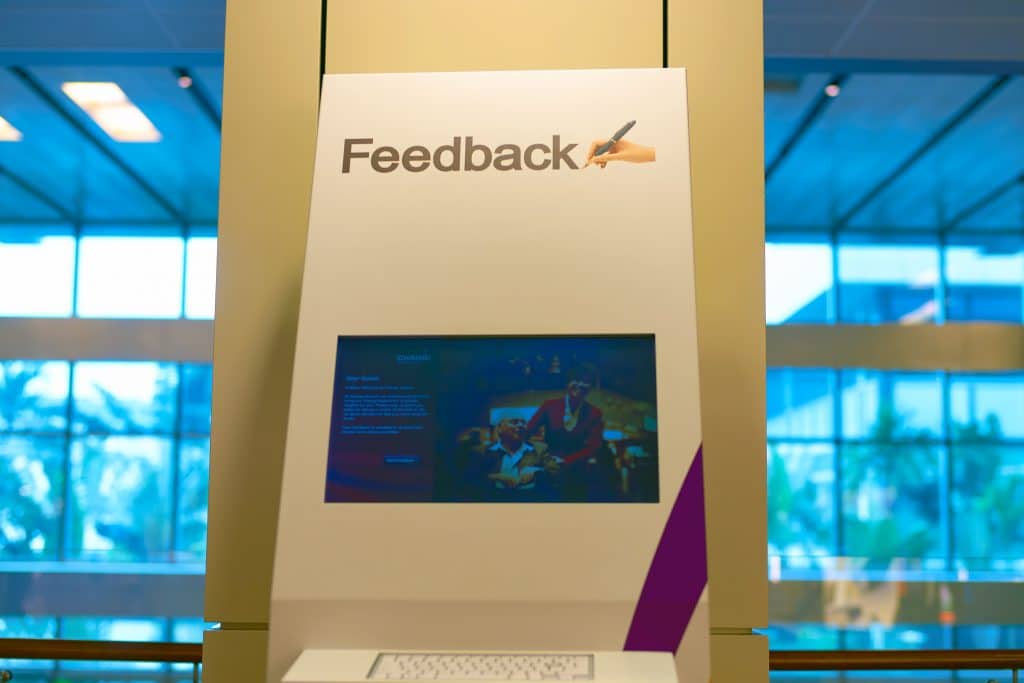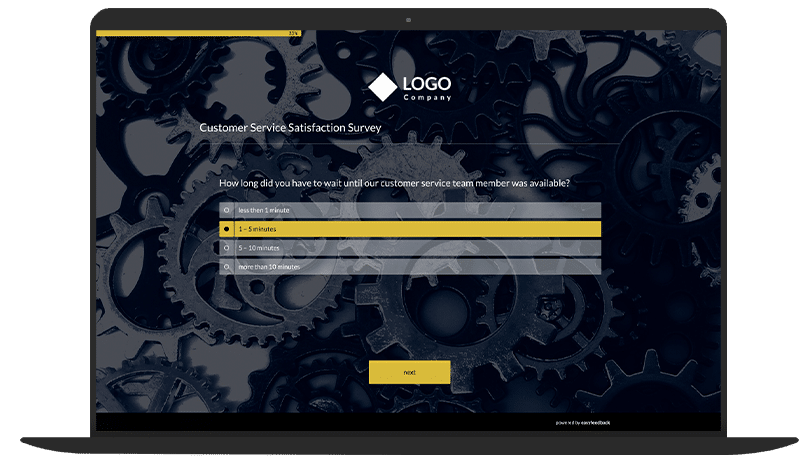Why you should regularly collect customer feedback?
Simple. Customer feedback helps you understand what you’re doing well and what you’re doing poorly, how your customers are doing, and how you can improve the relationship.
Because customer needs change quickly, and if you don’t respond to them, it can lead to dissatisfaction on the part of your customers.
Only with feedback can you look into the minds of your customers and find out what their needs, expectations and wishes are, and what ideas and suggestions for improvement they have for you.
In particular, you also learn whether there are any problems or negative experiences with your product, your service or your company.
The feedback you receive serves as a starting point for the strategic orientation of your company, the adjustment of products and services and for the development of new measures as well as the correction of current ones.
In the following, I have listed further important reasons for regularly collecting customer feedback:
- Customer feedback gives you an update on customer satisfaction.
- Customer feedback helps you understand what you are doing well and what you are doing poorly.
- You can increase customer loyalty with the help of your customers’ feedback.
- Customer feedback gives you feedback on the current customer experience along all stages of the customer journey.
- Customer feedback is a performance indicator that helps you identify which audience and region is most relevant to you.
- Customer feedback is a warning system for potential customer churn.
- Customer feedback can serve as an impetus for new ideas in the area of product and service development.
- Customer feedback helps you not only to develop measures, but also to strategically align your company.
P. S.: Of course, there are more reasons why you should ask for feedback from your customers. But I think the eight reasons above are enough to explain why it's important to get customer feedback on a regular basis.
What are the best practices for collecting customer feedback?
Basically, there are many different ways to gather feedback from your customers.
To give you some ideas and inspiration, we have listed a selection of different feedback methods below. These proven methods are explained in more detail.
Method 1: Online customer surveys
If you want to collect feedback from your customers easily, flexibly and cost-effectively, and reach a large number of participants in the process, then online customer surveys are just the thing.
Online surveys have the advantage that they can be created quickly and easily with the right software. In most cases, these tools also offer ready-made templates that can either be adapted to your own needs or used immediately.
In addition, online surveys offer the possibility of reaching a large number of participants via various invitation options, for example, via survey link, e-mail, via pop-up and much more.
With the right survey tool, you can even save time evaluating the feedback.
Your data is automatically converted into tables and charts. You can filter and compare them based on responses, participant groups or behaviors for even deeper analysis.
In terms of data protection, some online survey tools also offer confidential and GDPR compliant handling.
If you particularly want to strengthen the trust of survey participants in the survey, easyfeedback, for example, offers 100% technical anonymization during participation.
If you haven’t conducted surveys with an online feedback tool before, give it a try. Save time when creating, distributing and evaluating surveys.
Surprise your respondents with an interactive and unique user experience for a higher response rate and higher quality answers.
Reach your respondents through a variety of invitation options and let them participate conveniently via desktop, tablet, or smartphone, anywhere, anytime.
Method 2: Written customer surveys
The paper questionnaire as a survey method is still a good alternative to the digital survey if you or your target group are rather conservative on the road and followers of traditional methods.
It is designed by hand or on the computer using an online tool and printed out in paper form. It is then distributed (by mail) and collected again after customers have filled it out by hand.
Finally, a manual evaluation of the answers given is carried out.

Method 3: Oral survey – 1:1 interview
If you want to create a direct mood picture of your customers, then the oral survey is still one of the most effective methods.
Oral surveys can be conducted all the time – scheduled or not – for example, via live chat or phone contact.
Once you have contact with customers, you can always ask if they are satisfied and where there is room for improvement.

The oral survey thus always takes place on the side. However, it can also take place in a structured manner and with targeted customers.
Method 4: Feedback via online review platforms
For many customers, online review platforms such as Capterra or Google Reviews are a way to share their experiences with companies and their products with others in a publicly visible way.
At the same time, these reviews should not be underestimated. For many potential customers, they are a trustworthy source for decision-making.
Companies should therefore make sure that they constantly monitor the feedback on these rating portals. These reviews often contain valuable information about what is going well and what is going badly.
Take especially negative opinions seriously and try to understand why your customers are dissatisfied.
You can also contact the dissatisfied customers. This way you can learn more about what led to their dissatisfaction. Learn from it and try to do better.
Use the power of such portals not only to locate negative feedback, but ask your regular customers if they can leave a positive contribution.
The more positive your company is rated on these portals, the easier it is for potential customers to make a buying decision in favor of your company.
Method 5: Feedback terminals

If you want to receive direct feedback on site from your customers, for example at sales or service points, you can implement this using a so-called “feedback terminal“.
These machines are simply placed where the feedback is to be received. Customers usually give their anonymous feedback to a question, which makes the survey quick and easy.
In this way, current opinions and moods can be captured.
Method 6: On-site and in-app feedback

With on-site and in-app surveys, you can collect feedback in a short time and to the point from a sample of users of your website, tool, or app on a specific topic.
To do this, the survey is embedded directly within the content or as a pop-up, for example.
This way, the participant can take part in the survey directly without leaving the page, the app or the software.
Method 7: Usability tests
If you want to test the usability of a website, software, app or anything else, you can use usability tests to gather feedback from potential users and buyers.
With the feedback received, companies can identify potential for improvement during product development or after the product has been completed, as well as gather ideas to optimize the object of study in line with the target group.
Aside:
If you want to test a software, app or anything else for usability yourself, then we have a suitable survey template for you, with which you can quickly and reliably measure the user experience of interactive products.

We also offer a template for your website, with which you can have it evaluated for usefulness, aesthetics and stability.

Method 8: Pop-up events
Pop-up events are becoming increasingly popular with companies, because they offer prospective customers of the brand and the product an unusual and exclusive experience that is only offered for a short time (usually a few hours) in a location.
Pop-up events are usually planned spontaneously and their exclusive character gives recipients the impression that they should not miss the event.
Interested parties are given the opportunity to come into contact with the company, the brand, the products and the service via the “spontaneous” experience, with the aim of building up an emotional bond.
When is the best time to solicit customer feedback?
The answer is:
There are different times to gather customer feedback.
That’s because the timing always depends on the objective and purpose of your survey.
For example, you can ask for regular customer feedback on product or service satisfaction on a monthly or quarterly basis to learn about problems and opportunities for improvement, or to measure customer satisfaction based on referral rates.
Another example of regular feedback could be wanting to improve the quality of your podcast through the opinions of your listeners.
As you can see, there are different scenarios where you can ask for feedback in a regular way.
Likewise, it’s also possible to ask for feedback in a precise way. This means that surveys are triggered (automatically) directly after a certain interaction.
An example would be if you want to optimize your customer support and ask about the user experience directly after the contact.

In general, these on-point surveys can be used along the entire customer experience.
Another example would be if you’ve added a new feature to your software or app and you want to get feedback directly from your users about that feature.
How can I successfully collect customer feedback?
Many find it difficult to collect feedback from customers for a specific research purpose.
Yet it can be quite simple. You have to think about certain points in advance.
So that you too can successfully collect customer feedback, I will give you the following 6 points for your next customer survey:
1. Define the goal and choose the survey method
In order to collect customer feedback successfully, you first have to clarify what the goal of your survey is. With what intention and above all for what purpose do you need the feedback of your customers.
The further procedure develops from the objective. This also includes the question of the survey method to be used. Target group and internal resources play just as much a role in the choice of survey method as the objective.
An example:
You want to get customer feedback on the shopping experience in your store. The target group tends to be younger, let's say between 16 and 29, so they are tech-savvy and tend to prefer digital media.
So, you can now either set up a feedback terminal in your store that asks your customers' satisfaction or you could create an online survey via a tool and, for example, embed the survey link on every receipt as a QR code.
2. Formulating the right cover letter
If you want your customers to participate in your online survey, you have to convince them already in the cover letter. You don’t have to write a long novel, but simply present the following content briefly and concisely:
- Greeting with personal address
- Reason for the survey
- Duration of the survey
- Advantages of participating, e.g. 10 % discount on the next purchase
- Link to the survey
- Contact person & sender details for queries
Remember:
Attention spans are short and your customers have other things to do.
3. Keep the survey short
Many customers often have little time to participate in surveys, and when they realize that the questionnaire is longer than they thought, they simply abandon the survey.
Therefore, try to ask only the most necessary information for your objective and be sparing in the use of mandatory questions.
4. Speak the language of your participants
Write the cover letter, the questions and the answers in the language of your participants.
For example, if you are interviewing a young target group, you can write more casually and use colloquial words. However, for an older target group, more formal. If it is a survey used in a professional context, then you can speak in technical jargon.
5. Start directly with the survey
Make the way to answering your questions short and do without a greeting. This will reduce the bounce rate immensely.
Besides, if you have formulated a cover letter, then all the necessary information is already there. Then you don’t need any additional information on a welcome page.
Try it out.
Quick Tip:
If you invite your customers to the survey by email, place the first question of your survey as a graphic in your mail.
This way you don't need a button or a welcome page, but start the survey directly by clicking on the graphic in the email. This way, you're already sure of the first answer and you've charmingly introduced your participants to the survey without them noticing.
6. Use sweepstakes and incentives
If you want to increase the participation rate of your survey, then the use of incentives is a good option. For example, you can use a competition or a voucher code as an incentive to participate in the customer survey.
Conclusion – No success without customer feedback
Glad you made it to the end of my post on the 8 methods for gathering customer feedback.
In closing, I just want to leave you with a few words.
If you think you can run your business successfully in the long run without customer feedback, you’re wrong. Because without regular customer feedback, (long-term) success will be difficult.
Customer needs and wishes change quickly and the competition never sleeps.
That’s why I’ve explained the importance of customer feedback in this post and shown you ways to successfully collect feedback.
Now it’s up to you what you do with the information in my article!





